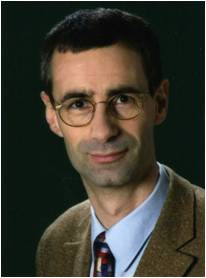
报告人简介: Gunther,Wittstock, Professor Department of Pure and Applied Chemistry纯粹和应用化学系 Carl von Ossietzky University of Oldenburg卡尔·冯·奥西埃茨基-奥尔登堡大学(德国) Prof. Wittstock于1986-1991年在德国莱比锡大学学习化学,并于1994年在该校取得分析化学博士学位。1992-1993年期间,在美国俄亥俄州辛辛那提大学William R. Heineman研究组工作,之后在位于莱比锡的威廉.奥斯特瓦尔德物理和理论化学研究所,利用表面光谱和扫描探针技术研究固/液微观界面反应,为其职业生涯奠定了坚实基础。期间获得洪堡奖学金资助,在慕尼黑工业大学从事相关研究工作。2001年成为奥尔登堡大学物理化学专业全职教授,电化学和凝聚态界面实验室的负责人。Prof. Wittstock小组利用扫描电化学显微镜,激光共聚焦显微镜,原子力显微镜,伏安法,PM IRRAS等先进技术制备有序薄膜,并详细表征和研究了其表面功能性质如催化活性,已发表了一百余篇研究性论文和撰写多本学术专著章节。目前,Prof. Wittstock担任奥尔登堡大学界面科学中心主任和博士生教育协调员,是国际电化学学会德国国家代表成员以及电化学研究中心负责人。 Biography: Gunther Wittstock studied chemistry at the University of Leipzig (1986-1991) and obtained a PhD in Analytical Chemistry in 1994 at the same University. From 1992-1993 he spent 11 months at the University of Cincinnati, Cincinnati, OH, USA with William R. Heineman. He prepared his habilitation at the Wilhelm Ostwald Institute of Physical and Theoretical Chemistry in Leipzig where he used surface spectroscopy and scanning probe techniques to investigate localized surface reactivity mainly at solid/liquid interfaces. During that time he was recipient of a Humboldt fellowship and spent the time at the Technical University of Munich. He became Full professor of Physical Chemistry at the University of Oldenburg in 2001 where he runs the laboratory of Electrochemistry and Condensed Matter Interfaces. The Wittstock group prepares and characterizes organized thin films and catalytically active surfaces with a wide variety of techniques (SECM, CLSM, AFM, voltammetry, PM IRRAS). He has authored 109+ peer-reviewed research papers and several book chapters. G.W. is head of the Center of Interface Science and programme coordinator of the corresponding PhD program at the University of Oldenburg. Currently, he serves as National representative for Germany in the International Society of Electrochemistry (ISE) and as Head of the Working Party of Electrochemical Research Institutions (AGEF).
报告摘要: 扫描电化学显微镜是一种扫描探针技术,利用微电极检测发生在固/液、液/液或者气/液界面反应物或者反应产物的连续变化。这里将对该技术原理进行详细说明。过去我们工作主要都集中在固定化酶的活性成像。最近研究的领域开始拓展到与能源转变相关材料上,如染料敏化太阳能电池和(生物)燃料电池的氧气催化还原。起初的尝试已经扩展到如何扩宽研究材料的范围和成像模式的应用范围。扫描电化学显微镜的反馈和产生-收集模式已被用于研究染料敏化太阳能电池半导体/电解质界面的光激发染料阳离子再生过程。现在开始关注更多复杂的反应,如太阳能的再生,燃料电池或染料敏化太阳能电池,。这些复杂的反应包括外部质量传输过程、内部质量和电荷传输过程、多孔物质的反应中心的本身活性。
Abstract:
Scanning electrochemical microscopy (SECM) is a scanning probe technique that uses an amperometric microelectrode to sense localized fluxes of reagents or products of reactions taking place at solid-liquid, liquid/liquid or gas/liquid interfaces. The principle ideas of the technique will be illustrated. In the past we have worked intensively on the activity imaging of immobilized enzymes. Recently, the scope of the studies was extended to materials relevant for energy conversion, e.g. dye sensitized solar cells and oxygen reduction catalysis for (bio) fuel cells. The initial attempts are currently expanded to widen the scope of investigated materials and imaging modes applicable. The SECM feedback and generation-collection modes were used to investigate the regeneration of photoexcited dye cations at the semiconductor/electrolyte interface in a dye-sensitized solar cell (DSSC). When investigated more complex reactions that come into the focus when dealing with solar fuel generation, fuel cells or DSSC are discussed. They include the combination of external mass transport and internal mass and charge transport and the intrinsic reactivity of the reaction centers within the porous materials.
|